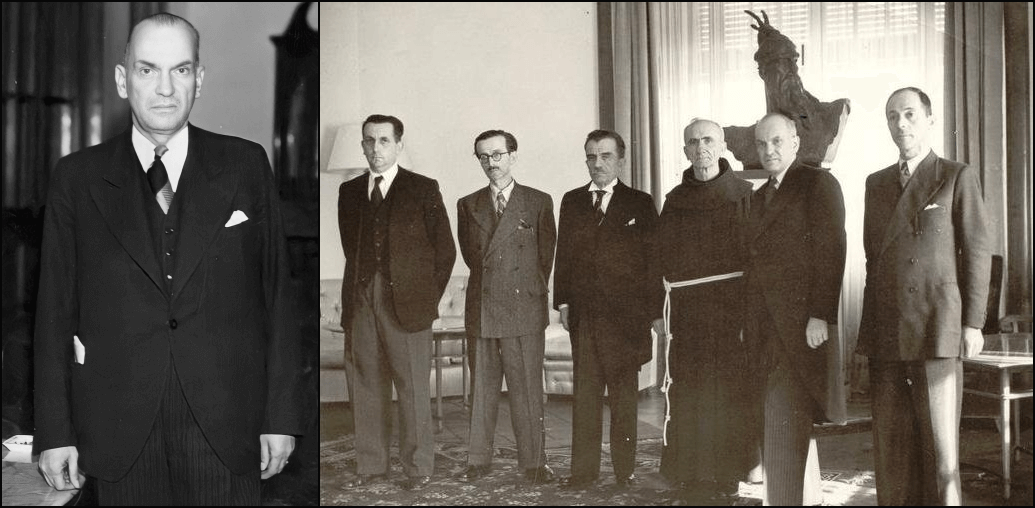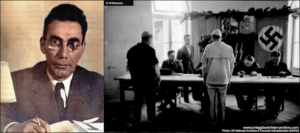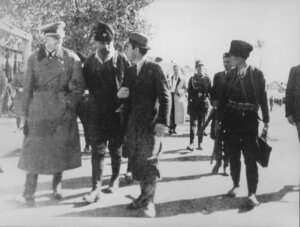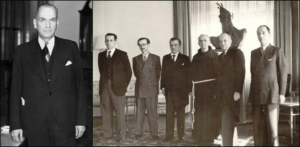Nazi collaborator monuments in Kosovo
Xhaver Deva, who helped create the SS Skanderbeg, has two streets named after him in Mitrovica and Pristina

Left: Rexhep Mitrovica (General Directorate of Archives via Wikimedia Commons). Right: the Albanian Regency Council, with Mehdi Frashëri third from left, Anton Harapi fourth from left and Rexhep Mitrovica fifth from left, 1943 (Wikimedia Commons). Image by Forward collage
This list is part of an ongoing investigative project the Forward first published in January 2021 documenting hundreds of monuments around the world to people involved in the Holocaust. We are continuing to update each country’s list; if you know of any not included here, or of statues that have been removed or streets renamed, please email [email protected], subject line: Nazi monument project.

Mitrovica and Pristina — Both cities have streets honoring Xhaver Deva (1904–1978). Deva, a Kosovo Albanian, was a leading figure in the political and paramilitary movement Balli Kombëtar, which collaborated with the Nazis and envisioned a Greater Albania based on the notion of “Albania for Albanians.”
In 1943, Deva became minister of interior in Albania’s newly-formed Nazi collaborationist government; in February 1944, forces under his command massacred 86 people suspected of being fascist resistance members in Tirana. Deva also recruited for the 21st Waffen Mountain Division of the SS “Skanderbeg” (1st Albanian), an Albanian Muslim formation in the Waffen-SS, the military arm of the Nazi Party. Shortly after SS Skanderbeg’s formation, its members rounded up and deported at least 281 Kosovo Jews — some researchers cite higher numbers — many of whom were subsequently murdered in the Bergen-Belsen concentration camp. After the war, Deva fled to the U.S. where he, like many ex-Nazi collaborators, enjoyed a productive relationship with the CIA.
A complicating factor in Deva’s legacy stems from the fact that the collaborationist government he was part of controlled not only Kosovo — a region north of Albania proper which was annexed to Albania in 1941 — but also Albania proper. The fate of Jews in Albania proper is markedly different from that of Jews in Kosovo.
Albania has an incredible history of saving Jews during the Holocaust: it is the only European nation to emerge from WWII with more Jews than it had in the beginning. Scholars suggest various reasons such as besa, the Albanian honor code which demands protection of guests and strangers seeking asylum, and the Third Reich’s relatively loose control over the countryside.
According to at least one Jewish survivor, Deva himself resisted handing over lists of Jews in Albania proper when pressured to do so by the Nazis. Unfortunately, due to the relative lack of research on the Holocaust in Albania, the extent to which the country’s collaborationist government aided versus resisted the Nazis is difficult to determine.
What is known is that Deva and other members of the Albanian puppet state were responsible for the creation of SS Skanderbeg, which sent Kosovo Jews to their deaths. Their government also resisted, to some degree, Third Reich demands to assist with the identification and roundup of Jews in Albania proper.
Deva surfaced in the news in February 2022, when it was discovered that the European Union and the United Nations Development Center were funding the renovation of his house in Mitrovica. After pressure from the Simon Wiesenthal Center and the German ambassador to Kosovo, the EU and the UN dropped their support of the restoration.
However, Deva’s house, which dates back to the 1930s, is not a monument to Deva in and of itself. It’s an existing historical structure and, as former Kosovo politician and journalist Veton Surroi noted on Twitter, “a building cannot inherit the sins of its builders.”
The restoration project would only become problematic if the house were to be transformed into a museum that whitewashed Deva’s legacy. If that happens, Deva’s house would qualify for inclusion in this project. As of April 2022, only Deva’s streets in Mitrovica and Pristina count as honors to a Nazi collaborator.
See the North Macedonia section for two statues of Balli Kombëtar leaders. Pictured above right is a SS Skanderbeg recruitment station in Prizren, 1944. Pictured below is a German military officer with Chetnik leader Kosta Pećanac and Deva in Podujevo in 1941.

***

Pristina and two other locales — Kosovo’s capital, Pristina, has several streets honoring members of Albania’s Nazi puppet government. These include streets named for prime minister Rexhep Mitrovica (1888–1967), above left, who also has a street in Mitrovica; minister of education Rexhep Krasniqi (1906–1999); and Anton Harapi (1888–1946), the Franciscan friar who was on the High Regency Council (Harapi has a second street in Peja). Mehdi Frashëri (1872–1963), another High Regency Council member, has a street in Mitrovica.
Above right, a meeting of the Albanian Regency Council, 1943, with Mehdi Frashëri third from left, Anton Harapi fourth from left and Rexhep Mitrovica fifth from left.

Gjurakoc and two other locales — Three sites in Kosovo honor Mid’hat Frashëri (1880–1949), a key figure in Albanian nationalism who became president of the Balli Kombëtar movement. Under Frashëri, Balli Kombëtar collaborated with Nazi Germany, including militarily. After the war, Frashëri established a working relationship with the CIA (see the New York Times reporting). In addition to his school (with a bust, above right), he has streets in Mitrovica and Pristina. See the Albania section for more streets to Frashëri as well as other Albanian Nazi collaborators.
The Forward is free to read, but it isn’t free to produce

I hope you appreciated this article. Before you go, I’d like to ask you to please support the Forward.
Now more than ever, American Jews need independent news they can trust, with reporting driven by truth, not ideology. We serve you, not any ideological agenda.
At a time when other newsrooms are closing or cutting back, the Forward has removed its paywall and invested additional resources to report on the ground from Israel and around the U.S. on the impact of the war, rising antisemitism and polarized discourse.
This is a great time to support independent Jewish journalism you rely on. Make a gift today!
— Rachel Fishman Feddersen, Publisher and CEO
Support our mission to tell the Jewish story fully and fairly.
Most Popular
- 1

Culture Cardinals are Catholic, not Jewish — so why do they all wear yarmulkes?
- 2

Fast Forward Ye debuts ‘Heil Hitler’ music video that includes a sample of a Hitler speech
- 3

News School Israel trip turns ‘terrifying’ for LA students attacked by Israeli teens
- 4

Fast Forward Student suspended for ‘F— the Jews’ video defends himself on antisemitic podcast
In Case You Missed It
-

Yiddish קאָנצערט לכּבֿוד דעם ייִדישן שרײַבער און רעדאַקטאָר באָריס סאַנדלערConcert honoring Yiddish writer and editor Boris Sandler
דער בעל־שׂימחה האָט יאָרן לאַנג געדינט ווי דער רעדאַקטאָר פֿונעם ייִדישן פֿאָרווערטס.
-

Fast Forward Trump’s new pick for surgeon general blames the Nazis for pesticides on our food
-

Fast Forward Jewish feud over Trump escalates with open letter in The New York Times
-

Fast Forward First American pope, Leo XIV, studied under a leader in Jewish-Catholic relations
-
Shop the Forward Store
100% of profits support our journalism
Republish This Story
Please read before republishing
We’re happy to make this story available to republish for free, unless it originated with JTA, Haaretz or another publication (as indicated on the article) and as long as you follow our guidelines.
You must comply with the following:
- Credit the Forward
- Retain our pixel
- Preserve our canonical link in Google search
- Add a noindex tag in Google search
See our full guidelines for more information, and this guide for detail about canonical URLs.
To republish, copy the HTML by clicking on the yellow button to the right; it includes our tracking pixel, all paragraph styles and hyperlinks, the author byline and credit to the Forward. It does not include images; to avoid copyright violations, you must add them manually, following our guidelines. Please email us at [email protected], subject line “republish,” with any questions or to let us know what stories you’re picking up.















